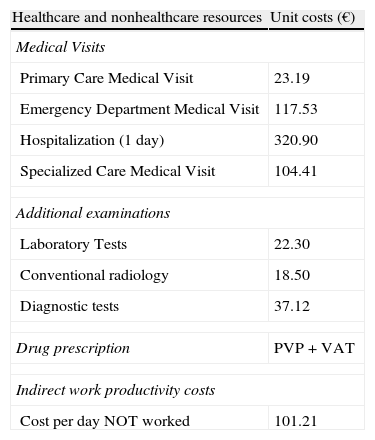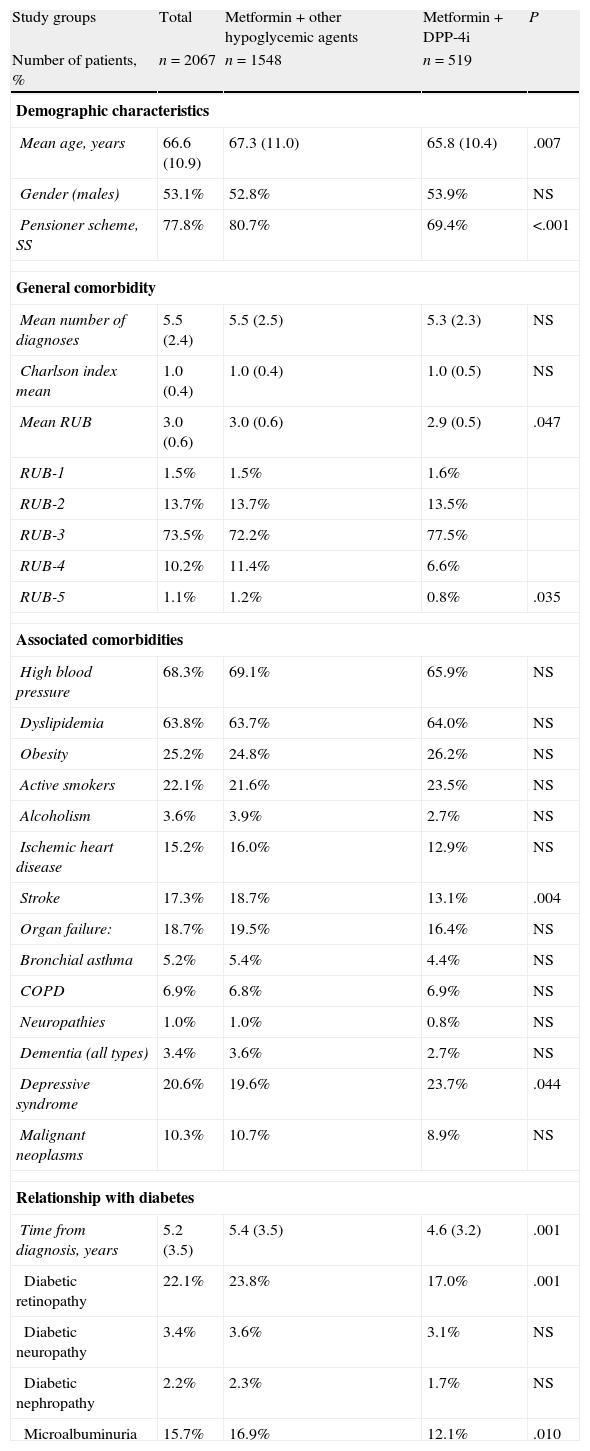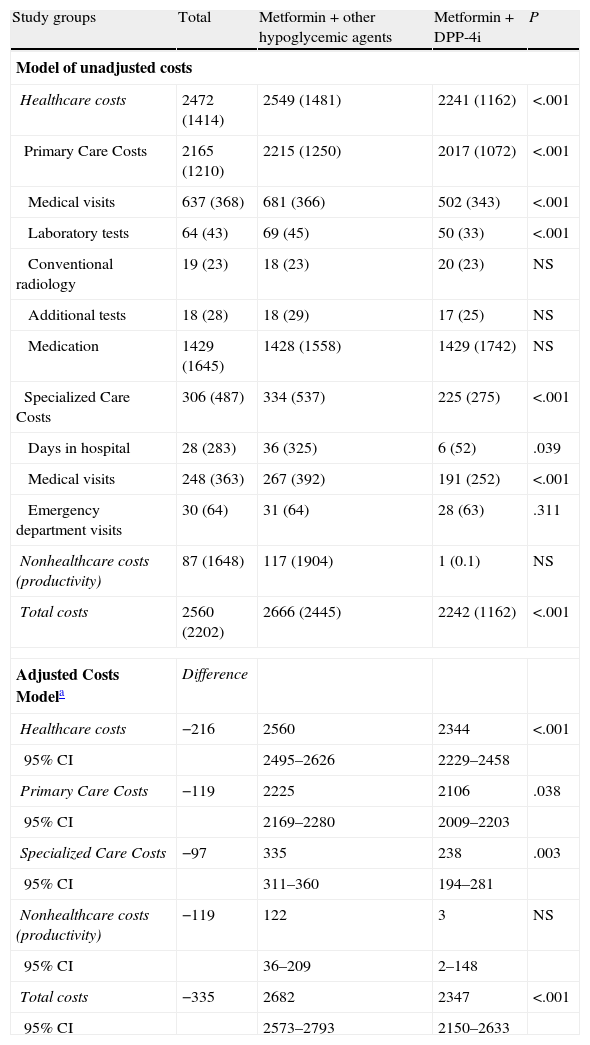There are different second line glucose lowering drugs whose efficacy, safety and economic profile have not been established in our setting. We have analyzed the clinical (diabetic treatment adherence, metabolic control, hypoglycemia and macrovascular complications) and economic (resource use and costs) consequences of the combination of metformin with dipeptidyl peptidase inhibitors (DPPIV) in patients with type 2 diabetes.
Patients and methodsWe conducted a multicenter, observational and retrospective study. Patients ≥30 years treated with metformin who initiated a second antidiabetic treatment during 2008–2009 were enrolled in the study. Two groups of patients were established: metformin with DPPIV and metformin with other diabetic drugs. The main measurements were comorbidity, compliance/persistence, metabolic control (glycosylated hemoglobin <7%), complications (hypoglycemia, macrovascular) and total costs. Patients were followed-up for 2 years.
ResultsA total of 2067 patients were enrolled (mean age: 66.6 years, 53.1% male). Of these, 519 patients (25.1%) were analyzed in the metformin+DPPIV group and 1548 patients (74.9%) in the group metformin+other antidiabetic drug. The DPPIV group patients showed better compliance (70.3 vs. 59.6%), persistence (63.4 vs. 51.0%) and metabolic control (64.3 vs. 59.6%), respectively (P<.001) compared to the other group. They also showed a lower proportion of hypoglycemia (13.9 vs. 44.3%), cardiovascular events (3.7 vs. 7.6%) and total costs (2347 vs. € 2682), P<.05.
ConclusionsDespite the limitations of the study, patients treated with metformin associated to DPPIV were more likely to show increased adherence, metabolic control and lower rates of hypoglycemia than those treated with metformin associated to other antidiabetics.
Existen diversos tratamientos farmacológicos hipoglucemiantes de segunda línea cuya eficacia, seguridad y perfil económico no se ha precisado en nuestro medio. Hemos analizado las consecuencias clínicas (adherencia al tratamiento antidiabético, control metabólico, hipoglucemias y complicaciones macrovasculares) y económicas (uso de recursos y costes) de la combinación de metformina con inhibidores de la dipeptidilpeptidasa (IDPP4) en pacientes con diabetes tipo 2 en comparación con metformina y otros fármacos hipoglucemiantes.
Pacientes y métodosEstudio observacional multicéntrico de carácter retrospectivo. Se incluyeron pacientes de ≥30 años tratados con metformina que iniciaron un segundo tratamiento antidiabético durante los años 2008-2009. Se establecieron 2 grupos de pacientes: metformina con IDPP4 y metformina con otros fármacos antidiabéticos. Las principales medidas fueron: la comorbilidad, el cumplimiento/persistencia, el control metabólico (hemoglobina glicosilada<7%), complicaciones (hipoglucemias, macrovasculares) y costes totales. El seguimiento se realizó durante 2 años.
ResultadosSe reclutaron 2.067 pacientes (edad media: 66,6 años; 53,1% varones). En el grupo metformina+IDPP4 se analizaron 519 pacientes (25,1%) y en el grupo metformina+otros fármacos antidiabéticos: 1.548 pacientes (74,9%). Los enfermos tratados con IDPP4, en comparación con los que recibieron metformina asociada a otros antidiabéticos, mostraron un mejor cumplimiento (70,3 vs. 59,6%), persistencia (63,4 vs. 51,0%) y control metabólico (64,3 vs. 59,6%) (p<0,001). También presentaron una menor proporción de hipoglucemias (13,9 vs. 44,3%), eventos cardiovasculares (3,7 vs. 7,6%) y costes totales (2.347 vs. 2.682€) (p<0,05) durante los 2 años del estudio.
ConclusionesA pesar de las limitaciones del estudio, los pacientes en tratamiento con metformina asociada a IDPP4 mostraron un mayor cumplimiento terapéutico, control metabólico y menores tasas de hipoglucemias que los enfermos tratados con metformina asociada a otros antidiabéticos.
Article
Diríjase desde aquí a la web de la >>>FESEMI<<< e inicie sesión mediante el formulario que se encuentra en la barra superior, pulsando sobre el candado.

Una vez autentificado, en la misma web de FESEMI, en el menú superior, elija la opción deseada.

>>>FESEMI<<<









